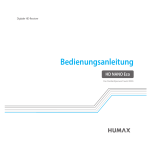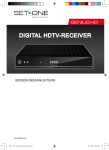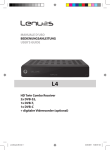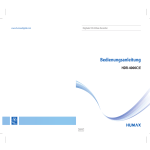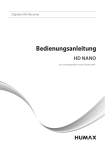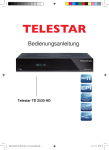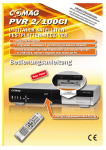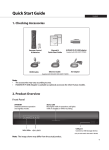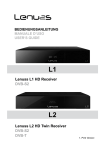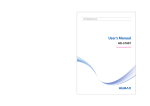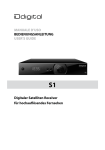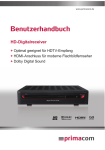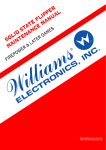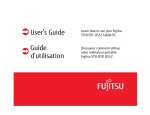Download Kurzanleitung
Transcript
Twin HDTV Satellitenreceiver Kurzanleitung HD FOX Twin Das Standardpasswort lautet 0000. www.humaxdigital.com Hinweis Hinweis Vielen Dank, dass Sie sich für ein Gerät von HUMAX entschieden haben. Lesen Sie diese Kurzanleitung aufmerksam durch, damit eine korrekte Installation, Verwendung und Pflege und somit eine optimale Leistung des Geräts gewährleistet ist. Bewahren Sie diese Kurzanleitung zum späteren Nachschlagen in der Nähe des Geräts auf. Änderungen der in dieser Kurzanleitung enthaltenen Informationen vorbehalten. Eine ausführliche Bedienungsanleitung finden Sie auf unserer Webseite www. humax-digital.de im Download-Bereich des HD FOX Twin. Copyright (Copyright © 2015 HUMAX Corporation) Dieses Dokument darf ohne die vorherige schriftliche Zustimmung von HUMAX weder ganz noch auszugsweise vervielfältigt, übersetzt oder anderweitig verwendet werden, es sei denn, der Inhaber der Urheberrechte willigt ein oder die Urheberrechtsgesetze lassen dies zu. Bedeutung der Symbole Um einen elektrischen Schlag zu vermeiden, entfernen Sie auf keinen Fall die obere Abdeckung (oder die Rückwand). Das Gerät enthält keine Bauteile, die vom Benutzer gewartet werden können. Wartungsarbeiten dürfen nur von qualifiziertem Fachpersonal durchgeführt werden. Dieses Symbol weist auf eine gefährliche Spannung im Innern des Geräts hin. Es besteht die Gefahr von Stromschlägen und Verletzungen. Dieses Symbol weist darauf hin, dass dem Gerät wichtige Anweisungen beiliegen. Warnungen und Hinweise Achten Sie in dieser Bedienungsanleitung besonders auf diese Symbole. Sie kennzeichnen Risiken oder Gefahrensituationen. Warnung Weist auf eine Gefahrensituation hin, die zu schweren Verletzungen führen könnte. Achtung Weist auf eine Situation hin, die zu Beschädigungen am Gerät oder anderen Apparaten führen könnte. Hinweis Liefert zusätzliche Informationen, die den Benutzer auf mögliche Probleme hinweisen oder ihm wichtige Informationen zur besseren Verständlichkeit, richtigen Verwendung und Pflege der Installation liefern. Garantie Die Garantie erstreckt sich nicht auf Teile, bei denen auf Grund einer falschen Anwendung der in dieser Bedienungsanleitung enthaltenen Informationen ein Defekt aufgetreten ist. WEEE-Hinweise Dieses Gerät darf am Ende seiner Betriebszeit nicht zusammen mit dem Hausmüll entsorgt werden. Entsorgen Sie es getrennt von anderen Müllarten, und lassen Sie es verantwortungsbewusst recyceln, damit die Materialressourcen nachhaltig wiederverwendet werden können. Dies schützt Ihre Umwelt und Gesundheit vor möglichen Schäden, die durch unkontrollierte Müllentsorgung hervorgerufen werden könnten. Privatkunden: Einzelheiten zu Sammelstellen und den möglichen umweltfreundlichen Recyclingverfahren erhalten Sie bei dem Händler, bei dem Sie dieses Gerät gekauft haben, oder bei den Behörden vor Ort. Gewerbliche Kunden: Wenden Sie sich an Ihren Lieferanten, und lesen Sie die allgemeinen Geschäftsbedingungen des Kaufvertrags. Dieses Gerät darf nicht zusammen mit anderem gewerblichen Abfall entsorgt werden. Marken • Nagravision ist eine eingetragene Marke von KUDELSKI S.A. • In Lizenz von Dolby Laboratories gefertigt. Dolby und das Doppel-D-Symbol sind Warenzeichen von Dolby Laboratories. • HDMI, das HDMI-Logo und High-Definition Multimedia Interface sind Marken und eingetragene Marken von HDMI Licensing LLC. Dieses Gerät beinhaltet Kopierschutztechnologien, die durch US-Patente und andere Rechte am geistigen Eigentum von Rovi Corporation geschützt sind. Reverse Engineering und Deassemblierung sind verboten. Hinweis: Die Modellbezeichnen finden Sie auf der Unterseite des Geräts. DE3 Hinweis EU-Konformitätserklärung HUMAX Co., Ltd erklärt hiermit, dass dieses Gerät HD FOX Twin den grundlegenden Anforderungen und sonstigen einschlägigen Bestimmungen der folgenden Richtlinien entspricht: - 2006/95/EG - Niederspannungsrichtlinie - 2004/108/EG - Richtlinie zur elektromagnetischen Verträglichkeit - 2009/125/EG - Ökodesign-Richtlinie - 2011/65/EU - RoHS-Richtlinie Das Gerät trägt die CE-Kennzeichnung. Die Konformitätserklärung gemäß den EG-Richtlinien ist für Länder der Europäischen Union unter der folgenden Adresse zur Einsicht verfügbar: http://www.humaxdigital.com/gm/ec.php DE4 Für Ihre Sicherheit Für Ihre Sicherheit Sicherheitshinweise 1. STROMVERSORGUNG • Betreiben Sie dieses Gerät nur an einer Stromquelle mit der auf dem Typenschild angegebenen Netzspannung. Falls Sie nicht sicher sind, welche Stromversorgung bei Ihnen vorliegt, wenden Sie sich an Ihr Energieversorgungsunternehmen. • Trennen Sie das Gerät von der Netzstromversorgung, bevor Sie Wartungs- oder Installationsarbeiten durchführen. 2. ÜBERLASTUNG • Stellen Sie sicher, dass Steckdose, Verlängerungskabel und Adapter entsprechend der für das Gerät geltenden Netzspannung ausgelegt sind. Andernfalls können ein elektrischer Schlag oder ein Brand die Folge sein. 3. FLÜSSIGKEITEN • Stellen Sie sicher, dass das Gerät nicht mit Flüssigkeiten in Kontakt kommt. Stellen Sie keine mit Flüssigkeiten gefüllten Gefäße auf das Gerät. 4. REINIGUNG • Ziehen Sie vor dem Reinigen des Geräts den Netzstecker aus der Steckdose. • Reinigen Sie das Gerät mit einem feuchten Tuch. Verwenden Sie keine Lösungsmittel. Wischen Sie die Oberfläche des Geräts vorsichtig mit einem weichen Tuch ab, da sie leicht zerkratzen könnte. 5. BELÜFTUNG • Stellen Sie sicher, dass die Belüftungsschlitze oben am Gerät nicht blockiert sind. Nur so kann eine ausreichende Belüftung des Geräts gewährleistet werden. • Stellen Sie keine anderen elektronischen Geräte auf dieses Gerät. • Stellen Sie keine Gegenstände auf das Gerät. Andernfalls könnten die Belüftungsschlitze blockiert oder die Geräteoberfläche beschädigt werden. 6. ZUBEHÖR • Schließen Sie nur ausdrücklich dafür vorgesehene Zubehörteile an das Gerät an. Andernfalls kann es zu Gefährdungen oder Schäden am Gerät kommen. 7. GEWITTER UND BETRIEBSPAUSEN • Trennen Sie bei Gewitter oder wenn das Gerät längere Zeit nicht in Gebrauch ist sowohl das Gerät von der Netzsteckdose als auch die Antenne vom Gerät. Dadurch wird eine Beschädigung des Geräts aufgrund von Blitzschlag oder Stromstößen verhindert. 8. FREMDKÖRPER • Stecken Sie keine Gegenstände durch die Öffnungen ins Innere des Geräts, da sie gefährliche stromführende Teile berühren oder Bauteile beschädigen könnten. 9. ERSATZTEILE • Stellen Sie sicher, dass ausschließlich vom Hersteller empfohlene Ersatzteile verwendet werden oder solche Teile, deren Bauart mit den Originalteilen identisch ist. Die Verwendung nicht geeigneter Ersatzteile kann weitere Schäden am Gerät verursachen. 10.ANSCHLUSS AN EINE SATELLITENSCHÜSSEL (LNB)/ KABELBUCHSE/ANTENNE • Trennen Sie die Stromversorgung, bevor Sie das Kabel an die Satellitenschüssel, den Kabelanschluss oder die Antenne anschließen bzw. von diesen abziehen. Andernfalls können Schäden am LNB, dem Kabelanschluss oder der Antenne die Folge sein. 11. ANSCHLUSS AN DAS FERNSEHGERÄT • Trennen Sie die Stromversorgung, bevor Sie das Kabel an das Fernsehgerät anschließen oder von diesem abziehen. Andernfalls können Schäden am Fernsehgerät die Folge sein. 12. ERDUNG (nur bei Satellitenanschluss) • Das LNB-Kabel muss an der Systemerde für die Satellitenschüssel geerdet werden. 13. AUFSTELLUNGSORT • Stellen Sie das Gerät nur in geschlossenen Räumen auf, um es vor Blitzschlag, Regen oder Sonneneinstrahlung zu schützen. Stellen Sie das Gerät nicht in der Nähe eines Heizkörpers oder eines Warmluftgebläses auf. • Wir empfehlen, dass zwischen diesem Gerät und anderen Geräten, die durch elektromagnetische Strahlungen gestört werden können (z. B. Fernsehgerät oder Videorekorder), ein Abstand von mindestens 10 cm eingehalten wird. • Wenn Sie das Gerät in ein Regal o. ä. stellen, sorgen Sie für ausreichende Belüftung, und beachten Sie die Hinweise des Herstellers zur Aufstellung des Geräts. • Stellen Sie das Gerät nicht auf einer instabilen Fläche auf, von der es herunterfallen könnte. Das Gerät könnte beim Herunterfallen Menschen ernsthaft verletzen und dabei selber schwer beschädigt werden. 14. UMWELT • Beachten Sie die für eine umweltgerechte Entsorgung von Batterien geltenden Vorschriften. • Bei Verwendung dieses Geräts in tropischen und/oder gemäßigten Klimazonen ist Vorsicht geboten. Vorsichtsmaßnahmen und Warnhinweise 1. SO VERMEIDEN SIE EINE BESCHÄDIGUNG VON NETZKABEL ODER NETZSTECKER: • Verändern oder manipulieren Sie Netzkabel und Netzstecker nicht. • Verbiegen oder verdrehen Sie das Netzkabel nicht. • Wenn Sie das Gerät vom Netz trennen, ziehen Sie nicht am Netzkabel, sondern fassen Sie den Stecker an. • Achten Sie darauf, dass das Netzkabel so weit wie möglich von Heizgeräten entfernt ist, um zu verhindern, dass die Kunststoffumantelung schmilzt. • Der Netzstecker muss als Trennvorrichtung vom Benutzer jederzeit leicht erreicht werden können. • Der Netzschalter muss jederzeit erreichbar sein. (für Modelle mit Netzschalter) 2. SO VERMEIDEN SIE EINEN STROMSCHLAG: • Öffnen Sie niemals das Gehäuse. • Stecken Sie keine metallenen oder entflammbaren Gegenstände in das Geräteinnere. • Berühren Sie den Netzstecker nicht mit nassen Händen. • Trennen Sie während eines Gewitters das Gerät vom Netz. • Ziehen Sie das Netzkabel ab, bevor Sie das Antennenkabel anschließen. 3. SO VERMEIDEN SIE SCHÄDEN AM GERÄT: • Verwenden Sie das Gerät auf keinen Fall, wenn es defekt ist. Wenn Sie ein defektes Gerät weiter verwenden, kann es schweren Schaden nehmen. Wenden Sie sich im Falle eines defekten Geräts an das Kundendienstzentrum. • Stecken Sie keine Metallgegenstände oder Fremdkörper in die Modul- oder Smartcard-Steckplätze. Das Gerät könnte Schaden nehmen, und seine Lebensdauer könnte sich dadurch verkürzen. DE5 Kurzanleitung Vorder- und Rückseite Mitgeliefertes Zubehör STANDBY Hiermit wechseln Sie zwischen Normalbetrieb und dem Standby-Modus. Der Knopf leuchtet blau während des Betriebs und rot im Standby oder Status Display während einer Aufnahme Anzeige z.B. des aktuellen Kanals. Kurzanleitung TV/RADIO RM-M05 Fernbedienung / Batterien Kurzanleitung HDMI-Kabel Netzteil Hinweis: Die verfügbaren Zubehörteile können je nach Region unterschiedlich sein. 1 1 2 3 4 5 6 7 1 LNB 2 IN/ 1 IN: Zum Anschließen eines Satellitenkabels. 2 SPDIF: Zum Anschließen an ein digitales Audiogerät über ein optisches SPDIF-Kabel. 3 HDMI: Zum Anschließen an das Fernsehgerät über ein HDMI-Kabel. 4 ETHERNET: Zum Anschließen eines Netzwerkkabels. 5 USB: Zum Anschließen eines USB-Speichergeräts. 6 e-SATA: Zum Anschließen eines eSATA-Speichergeräts. 7 Smartcard: Setzen Sie die Smartcard in den Steckplatz ein. 8 Stromanschluss: Hier schließen Sie das Stromkabel des Netzteils an. Hinweis: Nutzen Sie ein Satellitenkabel, schließen Sie dieses an LNB1 an. DE6 2 8 3 4 5 6 7 8 Einschieben der Smartcard 1. Halten Sie die Smartcard waagerecht, so dass der Elektronikchip nach unten zeigt. 2. Setzen Sie die Smartcard in den Steckplatz ein. Kurzanleitung Anschlussmöglichkeiten Anschließen der Antenne In diesem Abschnitt wird beschrieben, wie Sie Ihr Gerät so anschließen, dass es an die Konfiguration der angeschlossenen Geräte angepasst ist und eine optimale Signalqualität gewährleistet wird. Verbinden Sie Ihre Satellitenleitung mit LNB1 IN und LNB2 IN. Sollten Sie nur eine Satellitenzuleitung verwenden, schließen Sie diese an LNB1 IN an. Warnung: Schließen Sie zunächst alle Geräte an, bevor Sie das Netzteil an die Steckdose anschließen. Schalten Sie dieses Gerät, das Fernsehgerät und alle sonstigen Geräte aus, ehe Sie Kabel anschließen oder abziehen. Anschließen des Fernsehgeräts Antenna HDMI Die beste Bildqualität erreichen Sie, wenn Sie das Fernsehgerät über ein HDMI-Kabel anschließen. TV 1 Über ein HDMI-Kabel Hinweis: Wenn Sie ein digitales Audiosignal, (z.B. für Mehrkanalton) übertragen wollen, schließen Sie Ihr Audiosystem über ein optisches SPDIF-Kabel an. 2 Herstellen einer Netzwerkverbindung 3-1 Herstellen einer LAN-Verbindung 6 Ethernet 3-1 Router WLAN USB Dongle 3-2 Wireless Router Hinweis: • Wenn beim Anschließen des Geräts Probleme auftreten, wenden Sie sich an Ihren Fachhändler oder an den HUMAX-Kundendienst. • Wenn Sie das Fernsehgerät direkt an den HDMI-Ausgang des Geräts anschließen, erhalten Sie ein lebendigeres Bild und kommen in den Genuss von HD-Fernsehen. HDMI CEC Mit Hilfe des HDMI CEC (Consumer Electronic Control) Standards können Sie Geräte, die über ein HDMI Kabel verbunden sind und diesen Standard unterstützen, mit einer Fernbedienung steuern. Falls Ihr TV Gerät über den HDMI CEC Standard verfügt, schaltet sich ihr TV Gerät automatisch ein/aus, wenn sie den Receiver ein-/ausschalten. Schalten Sie hingegen Ihren TV ein/aus, reagiert der Receiver darauf nicht. 1. Verbinden Sie das Gerät über ein Ethernet-Kabel mit dem LAN-Router. 2. Stellen Sie die Optionen für die LAN-Verbindung ein. (Weitere Informationen finden Sie unter HOME > Einstellungen > Netzwerkeinstellungen.) 3-2 Herstellen einer WLAN-Verbindung 1. Benutzen Sie den HUMAX WLAN-USB-Stick, um sich drahtlos mit Ihrem Heimnetzwerk zu verbinden. 2. Wechseln Sie zu HOME > EINSTELLUNGEN > Netzwerkeinstellungen > WLAN konfigurieren, und stellen Sie die Optionen für die WLANVerbindung ein. Hinweis: • Wir empfehlen, den Netzwerkanschluss über eine direkte Kabelverbindung herzustellen. • Vergewissern Sie sich, dass die Entfernung zwischen dem WLANZugangspunkt und dem Gerät nicht zu groß ist. Dadurch kann die Qualität des Dienstes sinken. • Sollte der HUMAX WLAN-USB-Stick in Ihrer Ausstattungsvariante nicht mitgeliefert sein, erhalten Sie diesen als optionales Zubehör bei Ihrem Fachhändler. DE7 Kurzanleitung Fernbedienung 1 RED Hiermit öffnen Sie die HUMAX TV Apps STANDBY Hiermit wechseln Sie zwischen dem Normalbetrieb und dem Standby-Betrieb. TEXT Hiermit rufen Sie den digitalen Videotext-Dienst auf. SUB Liste der verfügbaren Untertitelsprachen AUDIO Anzeigen der Audiomöglichkeiten. Tasten der Wiedergabesteuerung Hiermit starten Sie einen Smart-Suchlauf. Hiermit rufen Sie die Optionsmenüs auf. Hinweis: Sollten Ihre Batterien eine schwache Restkapazität aufweisen, blinkt der STANDBY zweimal kurz, sobald Sie die HOME Taste drücken. PFEILTASTEN Hiermit bewegen Sie den Cursor nach oben, unten, links oder rechts. Fernbedienungs-App OK Auswählen eines Menus oder Bestätigen. YELLOW BLUE YELLOW YELLOW YELLOW VOL+/- RM-M05 DE8 Sie können dieses HUMAX-Gerät mit Ihrem Mobilgerät genauso bedienen wie mit einer herkömmlichen Fernbedienung. Es gibt unterschiedliche Apps für Smartphones und Tablets. RED RED BLUEBLUEBLUE Hiermit passen Sie die Lautstärke an. HOME Hiermit zeigen Sie das Hauptmenü an. GUIDE Hiermit zeigen Sie den Programmführer an. P ∧/∨ Hiermit wechseln Sie den Kanal oder die Seite. FARBTASTEN Hiermit navigieren Sie in interaktiven Anwendungen. ZIFFERNTASTEN (0-9) MUTE Hiermit schalten Sie den Ton stumm. TV/RADIO Umschalten zwischen TV- und Radio-Modus. TV/RADIO 2 Hiermit schließen Sie alle Fenster des Bildschirmmenüs (OSD). Hiermit kehren Sie zum vorherigen Kanal oderRED FensterGREEN zurück. GREEN GREEN YELLOW YELLOWYELLOW BLUE BLUE BLUE BACK GREEN GREEN GREEN Rücklauf, Wiedergabe, Vorlauf, Stopp, Pause, Aufnehmen PLUS EXIT REDRED RED Setzen Sie die Batterien ein, und achten Sie dabei auf die richtige Polung (Plus (+) und Minus (-)). SEARCH GREEN 2 Einsetzen der Batterien Battery 1 TV APPS Fernbedienung Hiermit können Sie alle Tasten entsprechend der echten Fernbedienung verwenden. Tastatur Hiermit können Sie unkompliziert Text eingeben. Einfach Hiermit können Sie die Haupttasten verwenden Voll Hiermit können Sie alle Tasten entsprechend der echten Fernbedienung verwenden. Smartphone Tablet Hinweis: Informationen zum Herunterladen der Remote-App finden Sie auf Seite 9. Kurzanleitung Assistent Mobilgeräte-Apps Der Installationsassistent wird automatisch gestartet, sobald Sie das Gerät zum ersten Mal einschalten oder das Menü auf die Werkseinstellungen zurücksetzen. Hinweis: Wenn Sie den Installationsassistenten vorzeitig abbrechen, stehen möglicherweise nicht alle Kanäle zur Verfügung. Wechseln Sie in diesem Fall zu HOME > EINSTELLUNGEN > Kanal-Einstellungen > Kanäle Suchen, und suchen Sie nach weiteren verfügbaren Kanälen. 1. Internetverbindung Stellen Sie sicher, dass das LAN-Kabel an den Ethernet-Anschluss angeschlossen oder die WLAN-Funktion aktiviert ist. Konfigurieren Sie die Netzwerkeinstellungen. 2. Kanalsuchlauf Wählen Sie die Art des Kanalsuchlaufs aus. • Schnellsuche: Die Standardkanäle von ASTRA1 (19.2 E) werden ohne Kanalsuche übernommen. • Automatisch: Alle Kanäle von ASTRA1 (19.2E) und HOTBIRD (13.0E) werden automatisch gesucht. • Überspringen: Wenn Sie eine Einkabelantenne (SCD) verwenden, überspringen Sie den Suchlauf und navigieren Sie zu HOME > Einstellungen > Installation. Hinweis: Die Option für eine Schnellsuche wird nur in Deutschland und Österreich angezeigt. 3. Ergebnis Das Ergebnis des Installationsassistenten wird angezeigt. Drücken Sie die Taste EXIT. Remote App Live TV TV Guide Media Player Fast alle Funktionen Ihres HUMAX-Geräts können Sie auf mit Ihrem Mobilgerät nutzen. Remote Hiermit können Sie Ihr Mobilgerät als Fernbedienung verwenden. Live TV Hiermit können Sie Live-TV auf Ihrem Mobilgerät sehen oder Aufnahmen oder Erinnerungen per Fernzugriff programmieren. Diese App wird im Laufe des Jahres 2015 für den HD FOX Twin nachgereicht. Für Live TV auf Ihrem Mobilgerät können Sie zwischenzeitlich SAT>IP Client Apps nutzen (z.B. HD+ TV Guide). TV Guide Diese App ermöglicht Ihnen einfach und schnell TV Aufnahmen oder Erinnerungen über das Internet auf Ihrem Mobilgerät zu programmieren. Aktivieren Sie dazu unter HOME > Einstellungen > Aufnahme-Einstellungen > HUMAX Remote-Aufnahme > Fernprogrammierung > ein, melden sich unter www.myhumax.net an und geben Ihren individuellen Registrierungscode ein. Media Player Hiermit können Sie Mediendateien von Ihrem HUMAX-Gerät oder anderen Geräten in Ihrem Heimnetzwerk direkt auf Ihrem Mobilgerät wiedergeben. Herunterladen eine Mobilgeräte-App 1. Öffnen Sie den Google Play Store oder den iTunes App Store, um Mobilgeräte-Apps von HUMAX herunterzuladen. 2. Geben Sie als Suchbegriff HUMAX ein. 3. Installieren Sie die HUMAX-Apps auf Ihrem Mobilgerät. Hinweis: • Es kann nicht garantiert werden, dass HUMAX-Apps auf allen Mobilgeräten gleichermaßen problemlos funktionieren. • Sowohl Ihr HUMAX-Gerät als auch Ihr Mobilgerät müssen mit demselben Netzwerk verbunden sein. • Einige der Funktionen sind nicht außerhalb des Heimnetzwerks verfügbar. • HUMAX-Mobilgeräte-Apps erfordern mindestens Android 4.0 bzw. mindestens iOS 6. DE9 Einstellungen Kanäle Suchen [Festantenne] KANÄLE SUCHEN Mit dem Kanalsuchlauf können Sie Ihre Antenne konfigurieren und die verfügbaren Fernseh- und Radiokanäle durchsuchen. MIT Typ umschalten Nur LNB Wählen Sie Ihren Antennentyp. Drücken Sie die Taste HOME. Wählen Sie Kanal-Einstellungen und anschließend Kanalsuchlauf aus. 1 2 3 Drücken Sie die Taste PLUS, und wählen Sie dann Antennentyp. Wählen Sie Festantenne, und drücken Sie dann die Taste OK. Wählen Sie Typ umschalten und dann Nur LNB oder DiSEqC. Wählen Sie einen Satelliten aus, und drücken Sie dann die Taste OK. • Satellit: Hiermit wählen Sie den Satelliten aus. • LNB-Frequenz: Hiermit stellen Sie die LNB-Frequenz ein. • 22-kHz-Ton: Hiermit aktivieren (Ein) bzw. deaktivieren (Aus) Sie diese Option. • DiSEqC: Hiermit wählen Sie den DiSEqC-Schalter. • Transponder testen: Hiermit überprüfen Sie den Signalstatus jedes Transponders und wählen den mit der besten Qualität aus. Wählen Sie OK. 4Wählen Sie unter dem Abbild des gewählten Satelliten Transponder aus, und drücken Sie dann die Taste OK. Wählen Sie einen Wert in der Transponderliste aus. 5Wählen Sie SUCHEN, und drücken Sie dann die Taste OK. Die gefundenen Kanäle werden angezeigt. 6Wählen Sie nach Abschluss des Suchlaufs SPEICHERN aus, und drücken Sie dann die Taste OK. Hinweis: • Wählen Sie Benutzerdefiniert, um die Werte direkt einzugeben. • Wählen Sie STOPP, und drücken Sie dann die Taste OK, um den Kanalsuchlauf zu beenden. • Wenn Sie den Antennentyp ändern, werden alle Kanäle gelöscht. • Das Standardpasswort lautet 0000. Wenn Sie Ihr Passwort vergessen haben, wenden Sie sich an den nächstgelegenen Fachhändler. Ändern der Suchoptionen • Netzwerksuchlauf: Wählen Sie Ein, um auf der Grundlage der Informationen des gewählten Transponders weitere Kanäle zu suchen. • Verschlüsselungsart: Alle – FTA – CAS • Kanaltyp: Alle – TV – Radio Wählen Sie OK, und drücken Sie dann die Taste OK. DE10 Fest antenne 1 Einkabel antenne Antennentyp Suchoption SUCHEN Option KANÄLE SUCHEN MIT Nur LNB Typ umschalten ASTRA 2 Universal Transponder Alle 2 SUCHEN option KANÄLE SUCHEN WED ASTRA 1 (19,2 E) Satellit Universal LNB-Frequenz 10714, H, 22000, A Transponder testen Stärke Qualität 3 OK ABBRECHEN KANÄLE SUCHEN MIT Typ umschalten ASTRA 2 Universal 4 Alle Keine Benutzerdefiniert Transponder Alle SUCHEN option Einstellungen Kanäle Suchen [SCD Antennte] KANÄLE SUCHEN Mit Einkabelsystem können Sie Programme über ein Kabel an mehrere Anwender verteilen, so dass für weitere elektronische Geräte nur ein Kabel erforderlich ist. Wenn Sie mehrere Satelliten-Receiver verwenden, stellen Sie immer nur einen Receiver ein, und deaktivieren Sie die anderen während der Einstellung. Einzelheiten dazu finden Sie im Handbuch der Satellitenantenne. Drücken Sie die Taste HOME. Wählen Sie Kanal-Einstellungen und anschließend Kanalsuchlauf aus. 1Drücken Sie die Taste PLUS, und wählen Sie dann Antennentyp. Wählen Sie Einkabelantenne, und drücken Sie dann die Taste OK. 2Wählen Sie SCD-Einstellung, und drücken Sie dann die Taste OK. • Tuner: Wählen Sie zwischen Tuner 1~2. • Benutzerband: Wählen Sie zwischen Benutzerband 1~8. • Bandfrequenz: Die Frequenz wird auf der Grundlage des Tuner-Kanals eingestellt. Wählen Sie OK. 3Wählen Sie einen Satelliten aus, und drücken Sie dann die Taste OK. • Satellit: Hiermit wählen Sie den Satelliten aus. • LNB-Frequenz: Hiermit stellen Sie die LNB-Frequenz ein. • Transponder testen: Hiermit überprüfen Sie den Signalstatus jedes Transponders und wählen den mit der besten Qualität aus. Wählen Sie OK. 4Wählen Sie unter dem Abbild des gewählten Satelliten Transponder aus, und drücken Sie dann die Taste OK. Wählen Sie einen Wert in der Transponderliste aus. 5Wiederholen Sie die oben beschriebenen Schritte, um weitere Satelliten einzustellen. 6Wählen Sie SUCHEN, und drücken Sie dann die Taste OK. Die gefundenen Kanäle werden angezeigt. 7Wählen Sie nach Abschluss des Suchlaufs SPEICHERN aus, und drücken Sie dann die Taste OK. Hinweis: • Wählen Sie Benutzerdefiniert, um die Werte direkt einzugeben. • Wählen Sie STOPP, und drücken Sie dann die Taste OK, um den Kanalsuchlauf zu beenden. • Wenn Sie den Antennentyp ändern, werden alle Kanäle gelöscht. • Das Standardpasswort lautet 0000. Wenn Sie Ihr Passwort vergessen haben, wenden Sie sich an den nächstgelegenen Fachhändler. • Für Benutzerband und Bandfrequenz müssen für jeden Tuner unterschiedliche Werte eingestellt werden. Typ umschalten Nur LNB Wählen Sie Ihren Antennentyp. Fest Antenne 1 SCD Antenne Antennentyp Suchoption SUCHEN option KANÄLE SUCHEN MIT SCD-Einstellung Position 1 Satellit Transponder - 2 SEARCH option SCD-Einstellung WED Tuner 1 Tuner Benutzerband 1 Benutzerband 1210Mhz Bandfrequenz Tuner Tuner Tuner 1 Frequenz Tuner 2 Frequenz 1400 Mhz 1210 Mhz 3 OK ABBRECHEN SCD-Einstellung WED Tuner 1 Satellit Universal LNB-Frequenz Transponder testen 10729, V, 22000, A Stärke Qualität 4 74% 21% OK ABBRECHEN DE11 Anhang Technische Daten Tuner und Kanal Speicher Tuneranzahl 2 Flash-Speicher NAND 256MB Eingangsstecker F-Buchse, IEC 169-24 RAM DDR3 1GB Frequenzbereich 950 MHz bis 2150 MHz Empfangspegel -25 dBm - -69 dBm Video HDMI/HDCP Vertikal: +13,5 V (+14,5 V bei hoher Spannung) Horizontal: +18 V (+18,9 V bei hoher Spannung) Strom: je max. 350 mA, max. 600 mA gesamt (Überlastungsschutz) Frequenz: 22 ± 2 KHz Amplitude: 0,65 ± 0,25 V Audio S/PDIF LNB-Versorgung und Polarisation 22-kHZ-Ton DiSEqC-Steuerung Version 1.0, SCD (Einzelkabel-System) Demodulation QPSK, 8PSK Eingangssymbolrate FEC-Modus (QPSK) DVB-S: 2~45Ms/s DVB-S2: 10~30Ms/s (QPSK, 8PSK) DVB-S: Auto,1/2,2/3,3/4,5/6,7/8 DVB-S2: Auto,1/2,3/5,2/3,4/5,5/6,8/9,9/10 (QPSK) Auto,3/5,2/3,3/4,5/6,8/9,9/10 (8PSK) Audio/Video/Dateneingang/-ausgang Dateneingang/-ausgang USB USB 2.0 Host (5V Dateiformat JPEG (.jpeg, .jpg, .jpe, .jfif), MP3 (.mp3, .mp2, .mp1), XviD Stromversorgung Typ externes Netzteil Eingangsspannung 200-240V ~ 50/60Hz Leistungsaufnahme 12V MPEG-2 ISO/IEC 13818 Spezifikation des Transport-Streams Profilebene MPEG-2MP@ML, MPEG-2MP@HL, MPEG-4 HP@L4 .1 Eingangsrate 15MB/s Max Videoformat 4:3, 16:9 Videoauflösung 1080p, 1080i, 720p, 576p, 576i Audiodekodierung MPEG/MusiCam Layer I & II, AC3 downmix Audiomodus Mono / Zweikanal / Joint Stereo / Stereo DE12 3.33A Allgemeines MPEG-Transportstrom A/V-Dekodierung Transport-Stream 0.5A Max.) Abmessungen 200 x 125 x 37.5 (mm) Gewicht (Netto) 340 g Umgebungstemperatur (Betrieb) Umgebungstemperatur (Lagerung) 0 °C bis +40 °C -10 °C bis +70 °C Hinweis: Änderungen der technischen Daten des Geräts vorbehalten. Anhang Open Source Software Notice HUMAX products use certain open source operating system software distributed pursuant to GNU GENERAL PUBLIC LICENSE Version 2 and GNU LESSER GENERAL LICENSE Version 2.1 each as defined and published by the Free Software Foundation, Inc. The following GPL and LGPL software source codes used in this product can be provided and this offer is valid for up to three years from the date of original download of the software or purchase of product containing such software. Please contact us at [email protected]. GPL Software busybox libext2fs compiler linux dnsmasq e2fsprogs mtd-utils parted xfsprogs ntpclient dosfstools rt3070 rt3572 libdsmcc tinyftp samba proftpd id3lib LGPL Software id3lib Libexif log4c uClibc DirectFB ffmpeg FreeType License (FTL) Software freetype Portions of this software are copyright © <2007> The FreeType Project (www.freetype.org). All rights reserved. OpenSSL License Software OpenSSL This product includes cryptographic software written by Eric Young.(eay@ cryptsoft.com) This product includes software written by Tim Hudson. ([email protected]) This product includes software developed by the OpenSSL Project for use in the OpenSSL Toolkit.(http://www.openssl.org) Use, modification and redistribution of the Open Source Software is governed by the terms and conditions of the applicable Open Source License. The GNU General Public License (GPL) v2 is shown below. The GNU General Public License (GPL) Version 2, June 1991 Copyright (C) 1989, 1991 Free Software Foundation, Inc.51 Franklin Street, Fifth Floor, Boston, MA 02110-1301, USA Everyone is permitted to copy and distribute verbatim copies of this license document, but changing it is not allowed. Preamble The licenses for most software are designed to take away your freedom to share and change it. By contrast, the GNU General Public License is intended to guarantee your freedom to share and change free software--to make sure the software is free for all its users. This General Public License applies to most of the Free Software Foundation’s software and to any other program whose authors commit to using it. (Some other Free Software Foundation software is covered by the GNU Lesser General Public License instead.) You can apply it to your programs, too. When we speak of free software, we are referring to freedom, not price. Our General Public Licenses are designed to make sure that you have the freedom to distribute copies of free software (and charge for this service if you wish), that you receive source code or can get it if you want it, that you can change the software or use pieces of it in new free programs; and that you know you can do these things. To protect your rights, we need to make restrictions that forbid anyone to deny you these rights or to ask you to surrender the rights. These restrictions translate to certain responsibilities for you if you distribute copies of the software, or if you modify it. For example, if you distribute copies of such a program, whether gratis or for a fee, you must give the recipients all the rights that you have. You must make sure that they, too, receive or can get the source code. And you must show them these terms so they know their rights. We protect your rights with two steps: (1) copyright the software, and (2) offer you this license which gives you legal permission to copy, distribute and/or modify the software. Also, for each author’s protection and ours, we want to make certain that everyone understands that there is no warranty for this free software. If the software is modified by someone else and passed on, we want its recipients to know that what they have is not the original, so that any problems introduced by others will not reflect on the original authors’ reputations. Finally, any free program is threatened constantly by software patents. We wish to avoid the danger that redistributors of a free program will individually obtain patent licenses, in effect making the program proprietary. To prevent this, we have made it clear that any patent must be licensed for everyone’s free use or not licensed at all. The precise terms and conditions for copying, distribution and modification follow. TERMS AND CONDITIONS FOR COPYING, DISTRIBUTION AND MODIFICATION 0. This License applies to any program or other work which contains a notice placed by the copyright holder saying it may be distributed under the terms of this General Public License. The “Program”, below, refers to any such program or work, and a “work based on the Program” means either the Program or any derivative work under copyright law: that is to say, a work containing the Program or a portion of it, either verbatim or with modifications and/or translated into another language. (Hereinafter, translation is included without limitation in the term “modification”.) Each licensee is addressed as “you”. Activities other than copying, distribution and modification are not covered by this License; they are outside its scope. The act of running the Program is not restricted, and the output from the Program is covered only if its contents constitute a work based on the Program (independent of having been made by running the Program). Whether that is true depends on what the Program does. 1. You may copy and distribute verbatim copies of the Program’s source code as you receive it, in any medium, provided that you conspicuously and appropriately publish on each copy an appropriate copyright notice and disclaimer of warranty; keep intact all the notices that refer to this License and to the absence of any warranty; and give any other recipients of the Program a copy of this License along with the Program. You may charge a fee for the physical act of transferring a copy, and you may at your option offer warranty protection in exchange for a fee. 2. You may modify your copy or copies of the Program or any portion of it, thus forming a work based on the Program, and copy and distribute such modifications or work under the terms of Section 1 above, provided that you also meet all of these conditions: a) You must cause the modified files to carry prominent notices stating that you changed the files and the date of any change. b) You must cause any work that you distribute or publish, that in whole or in part contains or is derived from the Program or any part thereof, to be licensed as a whole at no charge to all third parties under the terms of this License. c) If the modified program normally reads commands interactively when run, you must cause it, when started running for such interactive use in the most ordinary way, to print or display an announcement including an appropriate copyright notice and a notice that there is no warranty (or else, saying that you provide a warranty) and that users may redistribute the program under these conditions, and telling the user how to view a copy of this License. (Exception: if the Program itself is interactive but does not normally print such an announcement, your work based on the Program is not required to print an announcement.) These requirements apply to the modified work as a whole. If identifiable sections of that work are not derived from the Program, and can be reasonably considered independent and separate works in themselves, then this License, and its terms, do not apply to those sections when you distribute them as separate works. But when you distribute the same sections as part of a whole which is a work based on the Program, the distribution of the whole must be on the terms of this License, whose permissions for other licensees extend to the entire whole, and thus to each and every part regardless of who wrote it. Thus, it is not the intent of this section to claim rights or contest your rights to work written entirely by you; rather, the intent is to exercise the right to control the distribution of derivative or collective works based on the Program. In addition, mere aggregation of another work not based on the Program with the Program (or with a work based on the Program) on a volume of a storage or distribution medium does not bring the other work under the scope of this License. 3. You may copy and distribute the Program (or a work based on it, under Section 2) in object code or executable form under the terms of Sections 1 and 2 above provided that you also do one of the following: a) Accompany it with the complete corresponding machine-readable source code, which must be distributed under the terms of Sections 1 and 2 above on a medium customarily used for software interchange; or, b) Accompany it with a written offer, valid for at least three years, to give any third party, for a charge no more than your cost of physically performing source distribution, a complete machine-readable copy of the corresponding source code, to be distributed under the terms of Sections 1 and 2 above on a medium customarily used for software interchange; or, c) Accompany it with the information you received as to the offer to distribute corresponding source code. (This alternative is allowed only for noncommercial distribution and only if you received the program in object code or executable form with such an offer, in accord with Subsection b above.) The source code for a work means the preferred form of the work for making modifications to it. For an executable work, complete source code means all the source code for all modules it contains, plus any associated interface definition files, plus the scripts used to control compilation and installation of the executable. However, as a special exception, the source code distributed need not include anything that is normally distributed (in either source or binary form) with the major components (compiler, kernel, and so on) of the operating system on which the executable runs, unless that component itself accompanies the executable. If distribution of executable or object code is made by offering access to copy from a designated place, then offering equivalent access to copy the source code from the same place counts as distribution of the source code, even though third parties are not compelled to copy the source along with the object code. 4. You may not copy, modify, sublicense, or distribute the Program except as expressly provided under this License. Any attempt otherwise to copy, modify, sublicense or distribute the Program is void, and will automatically terminate your rights under this License. However, parties who have received copies, or rights, from you under this License will not have their licenses terminated so long as such parties remain in full compliance. 5. You are not required to accept this License, since you have not signed it. However, nothing else grants you permission to modify or distribute the Program or its derivative works. These actions are prohibited by law if you do not accept this License. Therefore, by modifying or distributing the Program (or any work based on the Program), you indicate your acceptance of this License to do so, and all its terms and conditions for copying, distributing or modifying the Program or works based on it. 6. Each time you redistribute the Program (or any work based on the Program), the recipient automatically receives a license from the original licensor to copy, distribute or modify the Program subject to these terms and conditions. You may not impose any further restrictions on the recipients’ exercise of the rights granted herein. You are not responsible for enforcing compliance by third parties to this License. 7. If, as a consequence of a court judgment or allegation of patent infringement or for any other reason (not limited to patent issues), conditions are imposed on you (whether by court order, agreement or otherwise) that contradict the conditions of this License, they do not excuse you from the conditions of this License. If you cannot distribute so as to satisfy simultaneously your obligations under this License and any other pertinent obligations, then as a consequence you may not distribute the Program at all. For example, if a patent license would not permit royalty-free redistribution of the Program by all those who receive copies directly or indirectly through you, then the only way you could satisfy both it and this License would be to refrain entirely from distribution of the Program. If any portion of this section is held invalid or unenforceable under any particular circumstance, the balance of the section is intended to apply and the section as a whole is intended to apply in other circumstances. It is not the purpose of this section to induce you to infringe any patents or other property right claims or to contest validity of any such claims; this section has the sole purpose of protecting the integrity of the free software distribution system, which is implemented by public license practices. Many people have made generous contributions to the wide range of software distributed through that system in reliance on consistent application of that system; it is up to the author/donor to decide if he or she is willing to distribute software through any other system and a licensee cannot impose that choice. This section is intended to make thoroughly clear what is believed to be a consequence of the rest of this License. 8. If the distribution and/or use of the Program is restricted in certain countries either by patents or by copyrighted interfaces, the original copyright holder who places the Program under this License may add an explicit geographical distribution limitation excluding those countries, so that distribution is permitted only in or among countries not thus excluded. In such case, this License incorporates the limitation as if written in the body of this License. 9. The Free Software Foundation may publish revised and/or new versions of the General Public License from time to time. Such new versions will be similar in spirit to the present version, but may differ in detail to address new problems or concerns. Each version is given a distinguishing version number. If the Program specifies a version number of this License which applies to it and “any later version”, you have the option of following the terms and conditions either of that version or of any later version published by the Free Software Foundation. If the Program does not specify a version number of this License, you may choose any version ever published by the Free Software Foundation. 10. If you wish to incorporate parts of the Program into other free programs whose distribution conditions are different, write to the author to ask for permission. For software which is copyrighted by the Free Software Foundation, write to the Free Software Foundation; we sometimes make exceptions for this. Our decision will be guided by the two goals of preserving the free status of all derivatives of our free software and of promoting the sharing and reuse of software generally. NO WARRANTY 11. BECAUSE THE PROGRAM IS LICENSED FREE OF CHARGE, THERE IS NO WARRANTY FOR THE PROGRAM, TO THE EXTENT PERMITTED BY APPLICABLE LAW. EXCEPT WHEN OTHERWISE STATED IN WRITING THE COPYRIGHT HOLDERS AND/OR OTHER PARTIES PROVIDE THE PROGRAM “AS IS” WITHOUT WARRANTY OF ANY KIND, EITHER EXPRESSED OR IMPLIED, INCLUDING, BUT NOT LIMITED TO, THE IMPLIED WARRANTIES OF MERCHANTABILITY AND FITNESS FOR A PARTICULAR PURPOSE. THE ENTIRE RISK AS TO THE QUALITY AND PERFORMANCE OF THE PROGRAM IS WITH YOU. SHOULD THE PROGRAM PROVE DEFECTIVE, YOU ASSUME THE COST OF ALL NECESSARY SERVICING, REPAIR OR CORRECTION. 12. IN NO EVENT UNLESS REQUIRED BY APPLICABLE LAW OR AGREED TO IN WRITING WILL ANY COPYRIGHT HOLDER, OR ANY OTHER PARTY WHO MAY MODIFY AND/OR REDISTRIBUTE THE PROGRAM AS PERMITTED ABOVE, BE LIABLE TO YOU FOR DAMAGES, INCLUDING ANY GENERAL, SPECIAL, INCIDENTAL OR CONSEQUENTIAL DAMAGES ARISING OUT OF THE USE OR INABILITY TO USE THE PROGRAM (INCLUDING BUT NOT LIMITED TO LOSS OF DATA OR DATA BEING RENDERED INACCURATE OR LOSSES SUSTAINED BY YOU OR THIRD PARTIES OR A FAILURE OF THE PROGRAM TO OPERATE WITH ANY OTHER PROGRAMS), EVEN IF SUCH HOLDER OR OTHER PARTY HAS BEEN ADVISED OF THE POSSIBILITY OF SUCH DAMAGES. END OF TERMS AND CONDITIONS How to Apply These Terms to Your New Programs If you develop a new program, and you want it to be of the greatest possible use to the public, the best way to achieve this is to make it free software which everyone can redistribute and change under these terms. To do so, attach the following notices to the program. It is safest to attach them to the start of each source file to most effectively convey the exclusion of warranty; and each file should have at least the “copyright” line and a pointer to where the full notice is found. One line to give the program’s name and a brief idea of what it does. Copyright (C) yyyy name of author This program is free software; you can redistribute it and/or modify it under the terms of the GNU General Public License as published by the Free Software Foundation; either version 2 of the License, or (at your option) any later version. This program is distributed in the hope that it will be useful, but WITHOUT ANY WARRANTY; without even the implied warranty of MERCHANTABILITY or FITNESS FOR A PARTICULAR PURPOSE. See the GNU General Public License for more details. You should have received a copy of the GNU General Public License along with this program; if not, write to the Free Software Foundation, Inc., 51 Franklin Street, Fifth Floor, Boston, MA 02110-1301, USA. Also add information on how to contact you by electronic and paper mail. If the program is interactive, make it output a short notice like this when it starts in an interactive mode: Gnomovision version 69, Copyright (C) year name of author Gnomovision comes with ABSOLUTELY NO WARRANTY; for details type `show w’. This is free software, and you are welcome to redistribute it under certain conditions; type `show c’ for details. The hypothetical commands `show w’ and `show c’ should show the appropriate parts of the General Public License. Of course, the commands you use may be called something other than `show w’ and `show c’; they could even be mouse-clicks or menu items-whatever suits your program. You should also get your employer (if you work as a programmer) or your school, if any, to sign a “copyright disclaimer” for the program, if necessary. Here is a sample; alter the names: Yoyodyne, Inc., hereby disclaims all copyright interest in the program `Gnomovision’ (which makes passes at compilers) written by James Hacker. signature of Ty Coon, 1 April 1989 Ty Coon, President of Vice This General Public License does not permit incorporating your program into proprietary programs. If your program is a subroutine library, you may consider it more useful to permit linking proprietary applications with the library. If this is what you want to do, use the GNU Library General Public License instead of this License. GNU Lesser General Public License (LGPL) Version 2.1, February 1999 Copyright (C) 1991, 1999 Free Software Foundation, Inc. 51 Franklin Street, Fifth Floor, Boston, MA 02110-1301 USA Everyone is permitted to copy and distribute verbatim copies of this license document, but changing it is not allowed. [This is the first released version of the Lesser GPL. It also counts as the successor of the GNU Library Public License, version 2, hence the version number 2.1.] Preamble The licenses for most software are designed to take away your freedom to share and change it. By contrast, the GNU General Public Licenses are intended to guarantee your freedom to share and change free software--to make sure the software is free for all its users. This license, the Lesser General Public License, applies to some specially designated software packages--typically libraries--of the Free Software Foundation and other authors who decide to use it. You can use it too, but we suggest you first think carefully about whether this license or the ordinary General Public License is the better strategy to use in any particular case, based on the explanations below. When we speak of free software, we are referring to freedom of use, not price. Our General Public Licenses are designed to make sure that you have the freedom to distribute copies of free software (and charge for this service if you wish); that you receive source code or can get it if you want it; that you can change the software and use pieces of it in new free programs; and that you are informed that you can do these things. To protect your rights, we need to make restrictions that forbid distributors to deny you these rights or to ask you to surrender these rights. DE13 Anhang These restrictions translate to certain responsibilities for you if you distribute copies of the library or if you modify it. For example, if you distribute copies of the library, whether gratis or for a fee, you must give the recipients all the rights that we gave you. You must make sure that they, too, receive or can get the source code. If you link other code with the library, you must provide complete object files to the recipients, so that they can relink them with the library after making changes to the library and recompiling it. And you must show them these terms so they know their rights. We protect your rights with a two-step method: (1) we copyright the library, and (2) we offer you this license, which gives you legal permission to copy, distribute and/or modify the library. To protect each distributor, we want to make it very clear that there is no warranty for the free library. Also, if the library is modified by someone else and passed on, the recipients should know that what they have is not the original version, so that the original author’s reputation will not be affected by problems that might be introduced by others. Finally, software patents pose a constant threat to the existence of any free program. We wish to make sure that a company cannot effectively restrict the users of a free program by obtaining a restrictive license from a patent holder. Therefore, we insist that any patent license obtained for a version of the library must be consistent with the full freedom of use specified in this license. Most GNU software, including some libraries, is covered by the ordinary GNU General Public License. This license, the GNU Lesser General Public License, applies to certain designated libraries, and is quite different from the ordinary General Public License. We use this license for certain libraries in order to permit linking those libraries into non-free programs. When a program is linked with a library, whether statically or using a shared library, the combination of the two is legally speaking a combined work, a derivative of the original library. The ordinary General Public License therefore permits such linking only if the entire combination fits its criteria of freedom. The Lesser General Public License permits more lax criteria for linking other code with the library. We call this license the “Lesser” General Public License because it does Less to protect the user’s freedom than the ordinary General Public License. It also provides other free software developers Less of an advantage over competing non-free programs. These disadvantages are the reason we use the ordinary General Public License for many libraries. However, the Lesser license provides advantages in certain special circumstances. For example, on rare occasions, there may be a special need to encourage the widest possible use of a certain library, so that it becomes a de-facto standard. To achieve this, non-free programs must be allowed to use the library. A more frequent case is that a free library does the same job as widely used non-free libraries. In this case, there is little to gain by limiting the free library to free software only, so we use the Lesser General Public License. In other cases, permission to use a particular library in non-free programs enables a greater number of people to use a large body of free software. For example, permission to use the GNU C Library in non-free programs enables many more people to use the whole GNU operating system, as well as its variant, the GNU/Linux operating system. Although the Lesser General Public License is Less protective of the users’ freedom, it does ensure that the user of a program that is linked with the Library has the freedom and the wherewithal to run that program using a modified version of the Library. The precise terms and conditions for copying, distribution and modification follow. Pay close attention to the difference between a “work based on the library” and a “work that uses the library”. The former contains code derived from the library, whereas the latter must be combined with the library in order to run. TERMS AND CONDITIONS FOR COPYING, DISTRIBUTION AND MODIFICATION 0. This License Agreement applies to any software library or other program which contains a notice placed by the copyright holder or other authorized party saying it may be distributed under the terms of this Lesser General Public License (also called “this License”). Each licensee is addressed as “you”. A “library” means a collection of software functions and/or data prepared so as to be conveniently linked with application programs (which use some of those functions and data) to form executables. The “Library”, below, refers to any such software library or work which has been distributed under these terms. A “work based on the Library” means either the Library or any derivative work under copyright law: that is to say, a work containing the Library or a portion of it, either verbatim or with modifications and/or translated straightforwardly into another language. (Hereinafter, translation is included without limitation in the term “modification”.) “Source code” for a work means the preferred form of the work for making modifications to it. For a library, complete source code means all the source code for all modules it contains, plus any associated interface definition files, plus the scripts used to control compilation and installation of the library. Activities other than copying, distribution and modification are not covered by this License; they are outside its scope. The act of running a program using the Library is not restricted, and output from such a program is covered only if its contents constitute a work based on the Library (independent of the use of the Library in a tool for writing it). Whether that is true depends on what the Library does and what the program that uses the Library does. 1. You may copy and distribute verbatim copies of the Library’s complete source code as you receive it, in any medium, provided that you conspicuously and appropriately publish on each copy an appropriate copyright notice and disclaimer of warranty; keep intact all the notices that refer to this License and to the absence of any warranty; and distribute a copy of this License along with the Library. You may charge a fee for the physical act of DE14 transferring a copy, and you may at your option offer warranty protection in exchange for a fee. 2. You may modify your copy or copies of the Library or any portion of it, thus forming a work based on the Library, and copy and distribute such modifications or work under the terms of Section 1 above, provided that you also meet all of these conditions: a) The modified work must itself be a software library. b) You must cause the files modified to carry prominent notices stating that you changed the files and the date of any change. c) You must cause the whole of the work to be licensed at no charge to all third parties under the terms of this License. d) If a facility in the modified Library refers to a function or a table of data to be supplied by an application program that uses the facility, other than as an argument passed when the facility is invoked, then you must make a good faith effort to ensure that, in the event an application does not supply such function or table, the facility still operates, and performs whatever part of its purpose remains meaningful. (For example, a function in a library to compute square roots has a purpose that is entirely well-defined independent of the application. Therefore, Subsection 2d requires that any application-supplied function or table used by this function must be optional: if the application does not supply it, the square root function must still compute square roots.) These requirements apply to the modified work as a whole. If identifiable sections of that work are not derived from the Library, and can be reasonably considered independent and separate works in themselves, then this License, and its terms, do not apply to those sections when you distribute them as separate works. But when you distribute the same sections as part of a whole which is a work based on the Library, the distribution of the whole must be on the terms of this License, whose permissions for other licensees extend to the entire whole, and thus to each and every part regardless of who wrote it. Thus, it is not the intent of this section to claim rights or contest your rights to work written entirely by you; rather, the intent is to exercise the right to control the distribution of derivative or collective works based on the Library. In addition, mere aggregation of another work not based on the Library with the Library (or with a work based on the Library) on a volume of a storage or distribution medium does not bring the other work under the scope of this License. 3. You may opt to apply the terms of the ordinary GNU General Public License instead of this License to a given copy of the Library. To do this, you must alter all the notices that refer to this License, so that they refer to the ordinary GNU General Public License, version 2, instead of to this License. (If a newer version than version 2 of the ordinary GNU General Public License has appeared, then you can specify that version instead if you wish.) Do not make any other change in these notices. Once this change is made in a given copy, it is irreversible for that copy, so the ordinary GNU General Public License applies to all subsequent copies and derivative works made from that copy. This option is useful when you wish to copy part of the code of the Library into a program that is not a library. 4. You may copy and distribute the Library (or a portion or derivative of it, under Section 2) in object code or executable form under the terms of Sections 1 and 2 above provided that you accompany it with the complete corresponding machine-readable source code, which must be distributed under the terms of Sections 1 and 2 above on a medium customarily used for software interchange. If distribution of object code is made by offering access to copy from a designated place, then offering equivalent access to copy the source code from the same place satisfies the requirement to distribute the source code, even though third parties are not compelled to copy the source along with the object code. 5. A program that contains no derivative of any portion of the Library, but is designed to work with the Library by being compiled or linked with it, is called a “work that uses the Library”. Such a work, in isolation, is not a derivative work of the Library, and therefore falls outside the scope of this License. However, linking a “work that uses the Library” with the Library creates an executable that is a derivative of the Library (because it contains portions of the Library), rather than a “work that uses the library”. The executable is therefore covered by this License. Section 6 states terms for distribution of such executables. When a “work that uses the Library” uses material from a header file that is part of the Library, the object code for the work may be a derivative work of the Library even though the source code is not. Whether this is true is especially significant if the work can be linked without the Library, or if the work is itself a library. The threshold for this to be true is not precisely defined by law. If such an object file uses only numerical parameters, data structure layouts and accessors, and small macros and small inline functions (ten lines or less in length), then the use of the object file is unrestricted, regardless of whether it is legally a derivative work. (Executables containing this object code plus portions of the Library will still fall under Section 6.) Otherwise, if the work is a derivative of the Library, you may distribute the object code for the work under the terms of Section 6. Any executables containing that work also fall under Section 6, whether or not they are linked directly with the Library itself. 6. As an exception to the Sections above, you may also combine or link a “work that uses the Library” with the Library to produce a work containing portions of the Library, and distribute that work under terms of your choice, provided that the terms permit modification of the work for the customer’s own use and reverse engineering for debugging such modifications. You must give prominent notice with each copy of the work that the Library is used in it and that the Library and its use are covered by this License. You must supply a copy of this License. If the work during execution displays copyright notices, you must include the copyright notice for the Library among them, as well as a reference directing the user to the copy of this License. Also, you must do one of these things: a) Accompany the work with the complete corresponding machine-readable source code for the Library including whatever changes were used in the work (which must be distributed under Sections 1 and 2 above); and, if the work is an executable linked with the Library, with the complete machinereadable “work that uses the Library”, as object code and/or source code, so that the user can modify the Library and then relink to produce a modified executable containing the modified Library. (It is understood that the user who changes the contents of definitions files in the Library will not necessarily be able to recompile the application to use the modified definitions.) b) Use a suitable shared library mechanism for linking with the Library. A suitable mechanism is one that (1) uses at run time a copy of the library already present on the user’s computer system, rather than copying library functions into the executable, and (2) will operate properly with a modified version of the library, if the user installs one, as long as the modified version is interfacecompatible with the version that the work was made with. c) Accompany the work with a written offer, valid for at least three years, to give the same user the materials specified in Subsection 6a, above, for a charge no more than the cost of performing this distribution. d) If distribution of the work is made by offering access to copy from a designated place, offer equivalent access to copy the above specified materials from the same place. e) Verify that the user has already received a copy of these materials or that you have already sent this user a copy. For an executable, the required form of the “work that uses the Library” must include any data and utility programs needed for reproducing the executable from it. However, as a special exception, the materials to be distributed need not include anything that is normally distributed (in either source or binary form) with the major components (compiler, kernel, and so on) of the operating system on which the executable runs, unless that component itself accompanies the executable. It may happen that this requirement contradicts the license restrictions of other proprietary libraries that do not normally accompany the operating system. Such a contradiction means you cannot use both them and the Library together in an executable that you distribute. 7. You may place library facilities that are a work based on the Library side-byside in a single library together with other library facilities not covered by this License, and distribute such a combined library, provided that the separate distribution of the work based on the Library and of the other library facilities is otherwise permitted, and provided that you do these two things: a) Accompany the combined library with a copy of the same work based on the Library, uncombined with any other library facilities. This must be distributed under the terms of the Sections above. b) Give prominent notice with the combined library of the fact that part of it is a work based on the Library, and explaining where to find the accompanying uncombined form of the same work. 8. You may not copy, modify, sublicense, link with, or distribute the Library except as expressly provided under this License. Any attempt otherwise to copy, modify, sublicense, link with, or distribute the Library is void, and will automatically terminate your rights under this License. However, parties who have received copies, or rights, from you under this License will not have their licenses terminated so long as such parties remain in full compliance. 9. You are not required to accept this License, since you have not signed it. However, nothing else grants you permission to modify or distribute the Library or its derivative works. These actions are prohibited by law if you do not accept this License. Therefore, by modifying or distributing the Library (or any work based on the Library), you indicate your acceptance of this License to do so, and all its terms and conditions for copying, distributing or modifying the Library or works based on it. 10. Each time you redistribute the Library (or any work based on the Library), the recipient automatically receives a license from the original licensor to copy, distribute, link with or modify the Library subject to these terms and conditions. You may not impose any further restrictions on the recipients’ exercise of the rights granted herein. You are not responsible for enforcing compliance by third parties with this License. 11. If, as a consequence of a court judgment or allegation of patent infringement or for any other reason (not limited to patent issues), conditions are imposed on you (whether by court order, agreement or otherwise) that contradict the conditions of this License, they do not excuse you from the conditions of this License. If you cannot distribute so as to satisfy simultaneously your obligations under this License and any other pertinent obligations, then as a consequence you may not distribute the Library at all. For example, if a patent license would not permit royalty-free redistribution of the Library by all those who receive copies directly or indirectly through you, then the only way you could satisfy both it and this License would be to refrain entirely from distribution of the Library. If any portion of this section is held invalid or unenforceable under any particular circumstance, the balance of the section is intended to apply, and the section as a whole is intended to apply in other circumstances. It is not the purpose of this section to induce you to infringe any patents or other property right claims or to contest validity of any such claims; this section has the sole purpose of protecting the integrity of the free software distribution system which is implemented by public license practices. Many people have made generous contributions to the wide range of software distributed through that system in reliance on consistent application of that system; it is up to the author/donor to decide if he or she is willing to distribute software through any other system and a licensee cannot impose that choice. This section is intended to make thoroughly clear what is believed to be a consequence of the rest of this License. 12. If the distribution and/or use of the Library is restricted in certain countries either by patents or by copyrighted interfaces, the original copyright holder who places the Library under this License may add an explicit geographical distribution limitation excluding those countries, so that distribution is permitted only in or among countries not thus excluded. In such case, this License incorporates the limitation as if written in the body of this License. 13. The Free Software Foundation may publish revised and/or new versions of the Lesser General Public License from time to time. Such new versions will be similar in spirit to the present version, but may differ in detail to address new problems or concerns. Each version is given a distinguishing version number. If the Library specifies a version number of this License which applies to it and “any later version”, you have the option of following the terms and conditions either of that version or of any later version published by the Free Software Foundation. If the Library does not specify a license version number, you may choose any version ever published by the Free Software Foundation. 14. If you wish to incorporate parts of the Library into other free programs whose distribution conditions are incompatible with these, write to the author to ask for permission. For software which is copyrighted by the Free Software Foundation, write to the Free Software Foundation; we sometimes make exceptions for this. Our decision will be guided by the two goals of preserving the free status of all derivatives of our free software and of promoting the sharing and reuse of software generally. NO WARRANTY 15. BECAUSE THE LIBRARY IS LICENSED FREE OF CHARGE, THERE IS NO WARRANTY FOR THE LIBRARY, TO THE EXTENT PERMITTED BY APPLICABLE LAW. EXCEPT WHEN OTHERWISE STATED IN WRITING THE COPYRIGHT HOLDERS AND/OR OTHER PARTIES PROVIDE THE LIBRARY “AS IS” WITHOUT WARRANTY OF ANY KIND, EITHER EXPRESSED OR IMPLIED, INCLUDING, BUT NOT LIMITED TO, THE IMPLIED WARRANTIES OF MERCHANTABILITY AND FITNESS FOR A PARTICULAR PURPOSE. THE ENTIRE RISK AS TO THE QUALITY AND PERFORMANCE OF THE LIBRARY IS WITH YOU. SHOULD THE LIBRARY PROVE DEFECTIVE, YOU ASSUME THE COST OF ALL NECESSARY SERVICING, REPAIR OR CORRECTION. 16. IN NO EVENT UNLESS REQUIRED BY APPLICABLE LAW OR AGREED TO IN WRITING WILL ANY COPYRIGHT HOLDER, OR ANY OTHER PARTY WHO MAY MODIFY AND/OR REDISTRIBUTE THE LIBRARY AS PERMITTED ABOVE, BE LIABLE TO YOU FOR DAMAGES, INCLUDING ANY GENERAL, SPECIAL, INCIDENTAL OR CONSEQUENTIAL DAMAGES ARISING OUT OF THE USE OR INABILITY TO USE THE LIBRARY (INCLUDING BUT NOT LIMITED TO LOSS OF DATA OR DATA BEING RENDERED INACCURATE OR LOSSES SUSTAINED BY YOU OR THIRD PARTIES OR A FAILURE OF THE LIBRARY TO OPERATE WITH ANY OTHER SOFTWARE), EVEN IF SUCH HOLDER OR OTHER PARTY HAS BEEN ADVISED OF THE POSSIBILITY OF SUCH DAMAGES. END OF TERMS AND CONDITIONS How to Apply These Terms to Your New Libraries If you develop a new library, and you want it to be of the greatest possible use to the public, we recommend making it free software that everyone can redistribute and change. You can do so by permitting redistribution under these terms (or, alternatively, under the terms of the ordinary General Public License). To apply these terms, attach the following notices to the library. It is safest to attach them to the start of each source file to most effectively convey the exclusion of warranty; and each file should have at least the “copyright” line and a pointer to where the full notice is found. one line to give the library’s name and an idea of what it does.> Copyright (C) year name of author This library is free software; you can redistribute it and/or modify it under the terms of the GNU Lesser General Public License as published by the Free Software Foundation; either version 2.1 of the License, or (at your option) any later version. This library is distributed in the hope that it will be useful, but WITHOUT ANY WARRANTY; without even the implied warranty of MERCHANTABILITY or FITNESS FOR A PARTICULAR PURPOSE. See the GNU Lesser General Public License for more details. You should have received a copy of the GNU Lesser General Public License along with this library; if not, write to the Free Software Foundation, Inc., 51 Franklin Street, Fifth Floor, Boston, MA 02110-1301 USA Also add information on how to contact you by electronic and paper mail. You should also get your employer (if you work as a programmer) or your school, if any, to sign a “copyright disclaimer” for the library, if necessary. Here is a sample; alter the names: Yoyodyne, Inc., hereby disclaims all copyright interest in the library `Frob’ (a library for tweaking knobs) written by James Random Hacker. signature of Ty Coon, 1 April 1990 Ty Coon, President of Vice Garantie Garantiekarte < BEDINGUNGEN 1. 2. WICHTIG: Bewahren Sie diese Karte zusammen mit der Original-Rechnung oder dem Kaufbeleg an einem sicheren Ort auf, und legen Sie sie bei einer Reparatur im Rahmen der Garantie auf Anfrage bei Ihrem Händler oder dem Geschäft vor, in dem Sie das Gerät erworben haben. 3. 4. 5. • Modellnr.: 6. • Seriennr.: 7. • Kaufdatum: • Unterschrift des Händlers: • Unterschrift des Käufers: HUMAX bedankt sich für den Kauf dieses HUMAX-Geräts. 8. Wir empfehlen Ihnen, auf dieser Karte die Seriennummer, die Sie am Gerät ablesen können, und sonstige Kaufinformationen zu notieren und die Karte zusammen mit dem Kaufbeleg in Ihrem persönlichen Unterlagen aufzubewahren. Auf diese Weise können wir Ihnen einen auf Ihre Bedürfnisse abgestimmten Service bieten. 9. Die HUMAX-Garantie gilt für einen Zeitraum von zwei Jahren ab dem Datum des Ersterwerbs. Wenn dieses Gerät innerhalb der Garantiedauer Funktionsstörungen aufweist, wird es vom Händler oder Vertriebspartner wieder in einen für die vorgesehenen Zwecke betriebsfähigen Zustand gebracht, ohne dass Kosten für Personal oder Material geltend gemacht werden. Diese Garantie gilt nur dann, wenn die Garantiekarte vom Käufer ordnungsgemäß ausgefüllt und dem Händler zusammen mit der Originalrechnung oder dem Kaufbeleg vorgelegt wird. Diese Garantie deckt keine Versand- oder Transportkosten für der Versand an uns ab. Die Haftung des Vertriebspartners ist auf die Reparatur defekter Bauteile beschränkt. Die Kosten und Risiken für den Ausbau, den Transport zum Händler und die erneute Installation des Geräts sowie alle sonstigen Kosten, die direkt oder indirekt mit der Reparatur verbunden sind, fallen nicht unter diese Garantie. Die Kosten für Reparaturen im Rahmen der Garantie, die von nicht autorisierten Werkstätten durchgeführt werden, können nicht erstattet werden, und die Garantie erlischt, wenn im Zuge dieser Reparatur Schäden am Gerät entstehen. Diese Garantie deckt ausschließlich Material- und Verarbeitungsfehler ab und umfasst insbesondere nicht das Folgende: a. regelmäßige Überprüfung, Anpassung, Wartung oder Umrüstung sowie der Austausch von Bauteilen aufgrund von normalem Verschleiß; b. Schäden aufgrund von Unfällen, Fahrlässigkeit, Modifizierungen, Einsatz von anderen als HUMAX-Originalersatzteilen, unsachgemäße Verwendung, Installation oder Verpackung; c. Schäden aufgrund von Blitzeinschlag, Überschwemmung, Brand, Krieg, Unruhen, falschen Netzspannungen, nicht ordnungsgemäßer Belüftung oder sonstigen Ursachen, die sich der Kontrolle des Vertriebspartners entziehen; d. Produkte, bei denen der Aufkleber mit der Seriennummer entfernt oder unkenntlich bzw. unleserlich gemacht wurde. Diese Garantie gilt für alle Personen, die innerhalb der Garantiedauer rechtmäßig in den Besitz dieses Geräts gelangt sind. Die Haftung von HUMAX ist auf den von Ihnen tatsächlich gezahlten Kaufpreis für dieses Gerät begrenzt. HUMAX haftet in keinem Fall für zufällige, Sonder-, Folge- oder Nebenschäden. < GARANTIEBEDINGUNGEN Bewahren Sie diese Karte zusammen mit der Original-Rechnung oder dem Kaufbeleg an einem sicheren Ort auf, und legen Sie es bei einer Reparatur im Rahmen der Garantie auf Anfrage bei Ihrem Händler oder dem Geschäft vor, in dem Sie das Gerät erworben haben. < HUMAX-VERBRAUCHERGARANTIE HUMAX garantiert vorbehaltlich der umseitig festgelegten Bedingungen, dass dieses Gerät frei von Material- und Verarbeitungsfehlern ist. HUMAX Call Center Tel: Öffnungszeiten: E-mail: Website: Sprache: 01806-778870 (20 Cent/Anruf aus dem dt. Festnetz / max. 60 Cent/Anruf aus Mobilfunknetzen) Mo-Sa 8:00-20:00 Uhr [email protected] www.humax-digital.de Deutsch/Englisch/Türkisch www.humaxdigital.com Q-GUIDE/HDNEOTWIN/100DE *20007-00606* 20007-00606 (HD NEO)

















